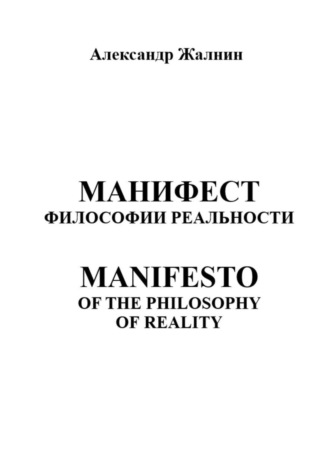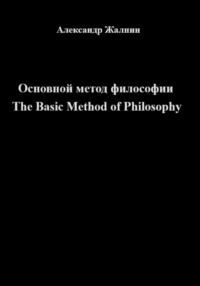
Полная версия
Манифест Философии Реальности. MANIFESTO OF THE PHILOSOPHY OP REALITY

Александр Жалнин
МАНИФЕСТ ФИЛОСОФИИ РЕАЛЬНОСТИ MANIFESTO OF THE PHILOSOPHY OP REALITY
МАНИФЕСТ ФИЛОСОФИИ РЕАЛЬНОСТИ MANIFESTO OF THE PHILOSOPHY OP REALITY
1) Зачем это нужно сейчас
Современная философия размыта между наукой, искусством и публицистикой; теряется её собственный предмет и критерий истины. «Философия реальности» предлагает вернуть философии чёткое место и практическую силу через Основной Метод Философии – регулируемый взаимопереход объективного и субъективного в мышлении и познании.
2) Определение
Философия Реальности – это способ мышления и дисциплина, систематически выделяющие в любом явлении две стороны реальности – объективную (рационально-логическую, природную) и субъективную (эмоционально-чувственную, сознательную) – и регулирующие их взаимопереход. Реальность при этом мыслится и как квазиобъект (целое: объект + его физический аналог в мозге), и как квазипонятие (способ связи субъекта и объекта в познании).
3) Основной метод Философии Реальности (ядро манифеста)
Выделяй стороны. В каждом предмете отделяй объективное и субъективное как реальные стороны одного и того же. Удерживай переход. Строй мышление так, чтобы результаты одной стороны проверялись и дополнялись другой (структура ↔ образ, факты ↔ переживание). Задавай нейронный мост. Понимай понятие двояко: как информационную структуру сознания и как физический аналог объекта в мозге; познание – это их согласованное формирование. Проверяй истину двусторонне. Истина – соответствие понятия явлению с обеих сторон; частичные соответствия дают мнение, предположение, убеждение и т.п.
4) Онтология Философии Реальности: взаимопереход «существование ↔ сущность»
Существование – предельно общее понятие объективной стороны (природы, фактичности).Сущность – предельно общее понятие субъективной стороны (сознания, смысла). Каждая сторона познаётся через другую: существование – как «вид» сущности и наоборот; их непрерывный переход и есть рабочая ткань реальности.
5) Место среди типов мышления
Философия Реальности объясняет и согласует доминанты других форм мышления:
Наука: преимущество объективного (формальное знание).Искусство: преимущество субъективного (переживание).Техника и практики: их прикладные миксы. Философия Реальности задаёт мета-уровень – как удерживать баланс и переходы между этими полюсами.
6) Понятийный минимум (рабочий словарь)
Реальность – связка мысли и вещи; «между» субъектом и объектом; первый шаг анализа – выделить обе стороны явления. Понятие – и информационная форма, и физический аналог объекта в мозге. Истина – двустороннее соответствие понятия явлению; ложь/префабрикации – перекосы одной из сторон. Живые понятия – интегрированные структуры, способные «работать» в сознании как процессы.
7) Нормы и правила мышления Философии Реальности
Не подменяй стороны. Идеальное/материальное, язык/мир и прочие дихотомии – частные проекции. Философии Реальности фиксирует именно субъективное/объективное и их переход. Избегай односторонности. Рассуждение только «по фактам» без чувственно-смысловой проверки – профанация; только «по переживанию» без объективной проверки – заблуждение; частичные совпадения – мнения, предположения, убеждения. Стандартизируй спор. Хороший спор – сопоставление объективных и субъективных характеристик предмета и полноты их взаимоперехода, а не столкновение «моей относительной истины» с «твоей».
8) Философия Реальности и мозг: объективная база метода
Познание имеет фазовую динамику: накопление материала → формирование «аналога» → его взаимодействие с объектом; отсюда – переживание «нарастания понимания». Философии Реальности утверждает естественную (нейрофизиологическую) опору философствования как функции переключения режимов мозга.
9) Практическая программа
Где Философии Реальности полезна прямо сейчас:
Качество мышления: методическая проверка понятий на двустороннюю состоятельность. Психологическая работа: разведение переживания и факта снижает зацикливание, навязчивые круги мысли. Здоровье/быт: гармонизация режимов сознания повышает устойчивость и ясность решений. Исследования и образование: любой предмет становится философским под углом взаимоперехода; при этом ФР не подменяет частные науки и не вторгается в их предмет.
10) Отношение к современным философиям
Философии Реальности не «сбоку от» традиций, а их сборка по рабочему признаку:
преодолевает распылённость постмодерна – возвращая единый критерий истины;соединяет ясность аналитики с глубиной переживания;снимает дуализм и редукционизм в философии сознания – через метод двух сторон и их перехода.
11) Критерии качества и границы применимости
Критерий качества: насколько полно и доказательно обеспечен взаимопереход сторон по данному предмету. Граница метода: там, где рациональный расчёт или чистое переживание достаточны по отдельности, философия избыточна; Философии Реальности нужна там, где требуется сведение сторон.
12) Институциональные шаги
Курс «Основной метод философии». Базовая техника выделения сторон, построения переходов и двусторонней верификации. Стандарты аргументации. Фиксация типов понятий (мнение/предположение/убеждение/истина) по таблице соответствий сторонам. Лаборатории «живых понятий». Практики конструирования и тестирования понятий как работающих процессов. Междисциплинарные узлы. Точки контакта науки, искусства, технологий – как поля применения метода без подмены их предметов.
13) Призыв
Философия Реальности это не «ещё одна» школу, а рабочий способ мыслить о любом предмете, где сущность и существование непрерывно переходят друг в друга. Вернём философии её предмет – регуляцию взаимоперехода сторон реальности, её критерий истины и её практическую пользу для человека и культуры.
Manifesto of the Philosophy of Reality
1) Why this is needed now
Contemporary philosophy is blurred between science, art, and journalism; its own proper subject and its criterion of truth are being lost. The Philosophy of Reality (PR) proposes to restore to philosophy a clear place and practical force through the Basic Method of Philosophy – the regulated mutual transition of the objective and the subjective in thinking and cognition.
2) Definition
The Philosophy of Reality is a mode of thinking and a discipline that systematically distinguishes, in any phenomenon, two sides of reality – the objective (rational-logical, natural) and the subjective (emotional-sensory, conscious) – and regulates their mutual transition.
Reality is thereby conceived both as a quasi-object (a whole: the object plus its physical analogue in the brain) and as a quasi-concept (a way of linking subject and object in cognition).
3) The Basic Method of the Philosophy of Reality (the core of the manifesto)
Distinguish the sides. In every object, separate the objective and the subjective as real sides of one and the same thing.
Maintain the transition. Organize thinking so that the results of one side are checked and complemented by the other (structure ↔ image, facts ↔ experience).
Set the neural bridge. Understand a concept in a dual way: as an informational structure of consciousness and as a physical analogue of the object in the brain; cognition is their coordinated formation.
Test truth from both sides. Truth is the correspondence of the concept to the phenomenon from both sides; partial correspondences yield opinion, conjecture, conviction, and so on.
4) Ontology of the Philosophy of Reality: the mutual transition “existence ↔ essence”
Existence is the most general concept of the objective side (nature, factuality).
Essence is the most general concept of the subjective side (consciousness, meaning).
Each side is known through the other: existence – as a “mode” of essence, and conversely; their continuous transition is the working fabric of reality.
5) Place among types of thinking
The Philosophy of Reality explains and reconciles the dominant tendencies of other forms of thinking:
Science: predominance of the objective (formal knowledge).
Art: predominance of the subjective (experience).
Technology and practices: their applied mixes.
The Philosophy of Reality provides a meta-level: how to sustain the balance and transitions between these poles.
6) Minimal conceptual set (working vocabulary)
Reality – the linkage of thought and thing; the “between” of subject and object; the first step of analysis is to distinguish both sides of the phenomenon.
Concept – both an informational form and a physical analogue of the object in the brain.
Truth – a two-sided correspondence of the concept to the phenomenon; falsehood / prefabrications are distortions of one of the sides.
Living concepts – integrated structures capable of “working” in consciousness as processes.
7) Norms and rules of thinking in the Philosophy of Reality
Do not substitute the sides. The ideal/material, language/world, and other dichotomies are partial projections. The Philosophy of Reality fixes precisely the subjective/objective and their transition.
Avoid one-sidedness. Reasoning “by facts only” without sensory-meaningful verification is profanation; reasoning “by experience only” without objective verification is delusion; partial coincidences are opinions, conjectures, convictions.
Standardize dispute. A good dispute is a comparison of the objective and subjective characteristics of the object and of the completeness of their mutual transition, not a clash of “my relative truth” with “yours.”
8) The Philosophy of Reality and the brain: the objective basis of the method
Cognition has a phase dynamics: accumulation of material → formation of an “analogue” → its interaction with the object; hence the lived experience of “growing understanding.”
The Philosophy of Reality affirms the natural (neurophysiological) basis of philosophizing as a function of switching brain modes.
9) Practical program
Where the Philosophy of Reality is directly useful today:
Quality of thinking: methodical testing of concepts for two-sided consistency.
Psychological work: separating experience from fact reduces fixation and obsessive loops of thought.
Health / everyday life: harmonizing modes of consciousness increases resilience and clarity of decisions.
Research and education: any subject becomes philosophical when viewed through the lens of mutual transition; at the same time PR does not replace particular sciences and does not encroach on their subject matter.
10) Relation to contemporary philosophies
The Philosophy of Reality is not “off to the side of” traditions, but their recomposition according to a working criterion:
it overcomes the diffuseness of postmodernism by restoring a single criterion of truth;
it unites the clarity of analytic philosophy with the depth of lived experience;
it resolves dualism and reductionism in the philosophy of mind through the method of two sides and their transition.
11) Criteria of quality and limits of applicability
Quality criterion: how fully and demonstrably the mutual transition of the sides is ensured for the given subject.
Limit of the method: wherever rational calculation or pure experience is sufficient on its own, philosophy is superfluous; the Philosophy of Reality is needed where the sides must be brought together.
12) Institutional steps
Course “The Basic Method of Philosophy”. Fundamental technique of distinguishing sides, building transitions, and two-sided verification.
Standards of argumentation. Fixing types of concepts (opinion / conjecture / conviction / truth) by a table of their correspondence to the sides.
Laboratories of “living concepts”. Practices of constructing and testing concepts as working processes.
Interdisciplinary hubs. Contact points of science, art, and technology as fields of application of the method without substituting their subject matters.
13) Call
The Philosophy of Reality is not just “one more” school, but a working way of thinking about any subject in which essence and existence continuously pass into one another.
Let us return to philosophy its subject – the regulation of the mutual transition of the sides of reality, its criterion of truth, and its practical usefulness for human beings and for culture.
Приложение 1. "Основной Метод Философии" Appendix 1. The Basic Method of Philosophy
Основной Метод Философии
A.Эйнштейн: Зависит ли истина от нашего сознания? Это проблема. Р.Тагор: То, что мы называем истиной, – это рациональная гармония между субъективными и объективными аспектами реальности… A.Einstein: Does the truth depend on our consciousness? This is a problem. R.Tagore: What we call truth is a rational harmony between the subjective and objective aspects of reality…
Introduction. The main problem of modern Philosophy
Modern Philosophy, unlike other disciplines, has one amazing feature: it does not know what it is. And the point here is not so much in the accuracy of the definitions of its subject matter, but in fundamental disagreements about its essence: some consider it science, others consider it art, still others consider it a special way of thinking, fourth find religion in it, fifth find mysticism, and so on, up to to those who consider it empty verbiage.
By the way, there are quite a few of the latter and their arguments are well founded: the quality of many philosophical publications is such that the difference between them and verbiage is sometimes rather arbitrary, if at all.
It should be noted that the matter of clarifying the essence of philosophy – if we talk about a common opinion – has long reached a dead end, so some suggest that philosophy should be considered what each particular philosopher thinks about it. True, this leaves open the question of how to determine who exactly is a philosopher and who is not.
Such a situation, on the one hand, attracts many people to “philosophy” who want to prove themselves in this “mysterious and incomprehensible” area, which makes it close to the people, and on the other hand, it litters it very much, as if in mathematics, along with with formulas and numbers, would use poems and music. In addition, the fuzziness of the modern understanding of philosophy attracts many individuals with fuzzy, eclectic, demagogic thinking, which in other disciplines is a sign of mental retardation.
For the same reasons, the development of philosophy itself also stopped: how can you develop something if you do not know what it is? Or, if we talk about the practical needs of understanding various life problems – what should philosophy develop to solve them, which would not be within the competence of many sciences and modern technologies? Many are looking for “wisdom” in philosophy, which is not found in the sciences and art, but if you start to understand the texts they offer for this title, it immediately becomes clear that this is a kind of fraud, only with the use of confusing terminology, which as a result does not promote solution to the problem.
Thus, we come to the question of the foundations of philosophy – and as we know, it is with the idea of wisdom that its emergence is connected. It is obvious that philosophizing is a type, a special way of thinking, or, to put it another way, it is a special way of thinking. Which, as was believed in antiquity, wise people possessed. Isn't that what Heraclitus meant when he said that much knowledge does not make the mind better?
Введение. Основная проблема современной философии
Современная философия, в отличие от иных дисциплин, имеет одну удивительную особенность: она не знает, что она есть такое. И дело здесь не столько в точности определений её предмета ведения, сколько в принципиальных разногласиях о её сущности: одни считают её наукой, другие считают её искусством, третьи – особенным способом мышления, четвёртые находят в ней религию, пятые – мистику и так далее, вплоть до тех, кто считает её пустым словоблудием.
К слову сказать, последних довольно-таки немало и их доводы имеют веские основания: качество многих философских публикаций таково, что разница между ними и словоблудием порою довольно условна, если вообще имеется.
Надо отметить, что дело с уяснением сущности философии – если говорить о едином мнении – давно зашло в тупик, так что некоторые предлагают считать философией то, что о ней думает каждый конкретный философ. Правда, при этом остаётся открытым вопрос о том, как определить кто именно является философом, а кто нет.
Подобная ситуация, с одной стороны, привлекает в “философию” множество людей, желающих проявить себя в этой “загадочной и непостижимой” области, что делает её близкой к народу, а с другой стороны очень сильно её захламляет, как если бы в математике, наряду с формулами и числами, использовали бы стихотворения и музыку. Кроме того, размытость современного понимания философии привлекает множество лиц с размытым, эклектичным, демагогическим мышлением, которое в других дисциплинах является признаком умственной отсталости.
По этим же причинам остановилось и развитие самой философии: как можно развивать нечто, если не знаешь, что оно есть? Или, если говорить о практических потребностях осмысления различных жизненных проблем – что должна развивать философия для их решения, чего не было бы в компетенции множества наук и современных технологий? Многие ищут в философии “мудрость”, которой нет в науках и искусстве, но если начать разбираться в предлагаемых ими на это звание текстах, то сразу же становится видно, что это разновидность мошенничества, только с применением запутанной терминологии, которая в результате никак не продвигает решение проблемы.
Таким образом, мы подходим к вопросу об основаниях философии – а как мы знаем, именно с представлением о мудрости связано её возникновение. Очевидно, что философствование это тип, особенный способ мышления, или, говоря по-другому, это особенный метод мышления. Которым, как считали в древности, обладали мудрые люди. Не это ли имел в виду Гераклит, говоря, что многознание ума не прибавляет?
The Place of the Philosophical Way in the System of Thinking
If philosophy is a special type of thinking, then we can define it by comparing it with other types of thinking: a) scientific and artistic in terms of the way of thinking and b) technological and personal in terms of the object of thinking.
The scientific type of thinking is characterized by the predominance of formalized and depersonalized content, a few axiomatic foundations, logic as a way of organizing content elements, and as a result, obtaining equally understood (formalized and unified) results, verified by evidence. The subject of scientific thinking is the search for patterns, that is, actions and relations of nature common to all people.
Artistic thinking is characterized by the predominance of figurativeness, emotionality of content, individual skill (talent) and personal attitude of the author as a way of organizing content elements, not strictly defined and numerous cultural grounds, and as a result, obtaining emotionally oriented results. The subject of artistic thinking is the identification and display of various states of human consciousness.
Technological thinking is characterized by a focus on the creation of technologies and material values – it uses elements of both scientific and artistic thinking. Personal thinking is characterized by a focus on the creation of spiritual and social values – it also uses elements of both scientific and artistic thinking. As you can see, technological and personal thinking are mixed types of thinking, which would be more correctly called varieties of thinking.
However, both scientific and artistic types of thinking, considered as opposites, also contain "impurities" of their opposite – in artistic thinking there is both logic and the generally accepted symbolic apparatus, and in scientific thinking there is both talent, imagery, and personal attitude. If we separate these "impurities" from the basis of the type of thinking, we will get two opposite characteristics of thinking: one is impersonal, logical, unemotional, based on the laws of nature, the other is personality-oriented, emotionally imaginative, based on states of consciousness.
These characteristics can be designated as the objective and subjective sides of thinking, or consciousness. In the real process of thinking, these two sides of consciousness or two phases of consciousness exist in dynamic unity, constantly changing their relationship to each other and switching the mode of brain operation from one to another. It is obvious that this process – the change of states of consciousness and phases of the functioning of the brain – is, on the one hand, a natural process, on the other hand, a process realized and regulated by consciousness. As a process realized and regulated by consciousness, it is neither a scientific nor an artistic type of thinking – it is a regulator of the relationship between the objective and subjective side of consciousness.
I consider the system of knowledge about this process and the ability to apply it the most adequate idea of what place the "philosophical type of thinking" should occupy.
Место философствования в системе мышления
Если философия – это особый тип мышления, то мы можем определить ее, сравнив с другими типами мышления: а) научным и художественным с точки зрения способа мышления и б) технологическим и личностным с точки зрения объекта мышления.
Научный тип мышления характеризуется преобладанием формализованного и обезличенного содержания, несколькими аксиоматическими основаниями, логикой как способом организации элементов содержания и, как следствие, получением одинаково понятных (формализованных и унифицированных) результатов, подтвержденных доказательствами. Предметом научного мышления является поиск закономерностей, то есть действий и отношений природы, общих для всех людей.
Художественное мышление характеризуется преобладанием образности, эмоциональности содержания, индивидуальным мастерством (талантом) и личным отношением автора как способа организации элементов содержания, не имеющих строго определенных и многочисленных культурных оснований, и, как следствие, получением эмоционально ориентированных результатов. Предметом художественного мышления является выявление и отображение различных состояний человеческого сознания.
Технологическое мышление характеризуется ориентацией на создание технологий и материальных ценностей – оно использует элементы как научного, так и художественного мышления. Личностное мышление характеризуется ориентацией на создание духовных и социальных ценностей – оно также использует элементы как научного, так и художественного мышления. Как вы можете видеть, технологическое и личностное мышление – это смешанные типы мышления, которые правильнее было бы назвать разновидностями мышления.











